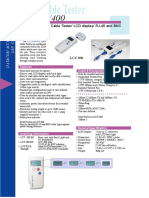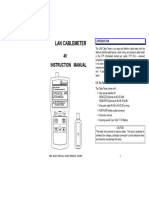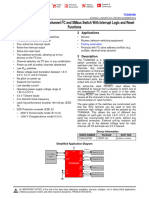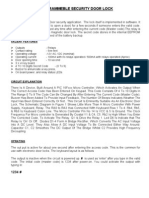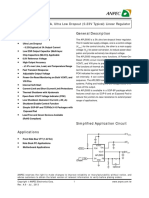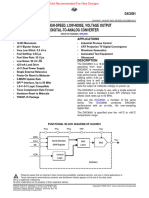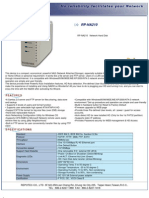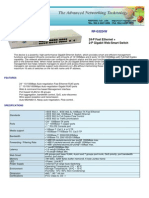RP 1703 ML
RP 1703 ML
Uploaded by
api-3736776Copyright:
Available Formats
RP 1703 ML
RP 1703 ML
Uploaded by
api-3736776Original Title
Copyright
Available Formats
Share this document
Did you find this document useful?
Is this content inappropriate?
Copyright:
Available Formats
RP 1703 ML
RP 1703 ML
Uploaded by
api-3736776Copyright:
Available Formats
LAN Cable Tester With LCT
User's Guide
Welcome
Thank you for purchasing this LAN Cable Tester Series product. Whether you are a contractor installing LAN cabling as a profession or simply a small
office administrator caring for a LAN, we hope that you will find this product both useful and rewarding.
Recognized
Specifications
Wiring
• LCD Display: 2 lines by 12 characters with LED back light Schemes
• Connectors: RJ-45 (8P8C) jacks with shield
• Control keys: MODE/SEL, ESC, and ENTER buttons 10(100)Base-T
• Power: 9V dry cell battery. Token Ring
• Size: 15.0(H) x 6.5(W) x 3.5(D) cm TP-PMD
• Weight: 180g net AT&T 258A
EIA/TIA-568A/B
USOC
Cable Types 10(100)Base/HUB
BNC/10Base-2
Unshielded Twisted Pair (UTP 100Ω, Cat 3,4 & 5) plus 4 User Defined
Foil screened Twisted Pair (FTP 100Ω and 120Ω, Cat 3,4 & 5)
Shielded Twisted Pair (STP 150Ω IBM Type 1&6)
RG-58 Coaxial cable (LCT400 ONLY)
Cable Locator
Cable location may be accomplished by using multiple RP-T terminators.
The RP-T locators incorporate factory set I.D. numbers and are available in
ID’s from 1 to 16.
Features
• Standard pin configurations and four(4) user defined cable wirings
• Hand-held and easy to operate. memorized in CPU.
• Easy to read LCD display, with back light. • Can save user defined cable directly after testing.
• Easy to diagnose RJ-45 cables (and BNC types with LCT400) with preset • Tests for both shielded and unshielded cable types.
wiring schemes. • Review the captured pin assignment and failure status.
• Easy to read cable status, verify cable continuity: open, short, and • Maximum testing length is up to 3000 feet.
mismatches. • Identify and trace the other end’s ID. (with up to 16 individual ID RP-T)
• Scan pin assignment. • Battery low indicator.
• Automatic cable identification. (Cable type search.) • Auto power-off function.
Automatic Power Saving Features
The LAN CABLE TESTER has built in power management features intended to extend battery life. By far, the LCD back light is the most power hungry
component in the LAN CABLE TESTER. Use of the LCD back light should therefore be limited to low ambient light applications. The back light may be
toggled ON/OFF by simultaneously pressing the MODE/SEL and ESC function keys. If there is no further menu selection or function testing within thirty
(30) seconds, the back light will be automatically extinguished. Additional power management functions include both a “sleep” mode and an auto “power
off” mode. If there is not any key activity for three (3) minutes, the unit will automatically enter “sleep” mode. All interface circuitry and the LCD display
will be powered down. In this mode the unit draws very little power. Pressing any key will cause the unit to “wake up” to a full functioning state. However,
if there is no key activity for ten (10) minutes, the unit will automatically “power off”. To recover from the “power off” mode, the unit must have its power
switch cycled OFF and then ON. In the “power off” mode the power usage is close to nil. This feature is especially useful if the unit is inadvertently left
powered on. The battery should be replaced when the battery low icon ( ) on the LCD display becomes visible during normal use of the LAN
CABLE TESTER . Additionally, if a low battery is swapped within 1 minute with a new one, the user defined memory contents will be retained. Just
remember to turn the unit OFF before swapping the battery.
Operation
← Connection: The LAN CABLE TESTER is capable of testing cables in any one of four modes.
Local Test mode is accomplished Terminator Loopback mode uses the
by connecting both ends of the supplied terminator ID block connected
cable under test to the LAN at the remote end of the cable, while the
CABLE TESTER OUT and other end of the cable is connected to the
LOOPBACK IN ports. Local unit LAN CABLE TESTER OUT.
displays an ID equal to zero.
Remote Test mode uses two (2)
LAN CABLE TESTER units,
with the cable connected between
one unit’s OUT and the other
unit’s LOOPBACK IN. Remote
unit displays an ID equal to zero.
Operation (continued)
Turn power switch on: Following initial power on of the LAN CABLE TESTER, the unit will display the startup logo with back light for 3 seconds,
then will display the top menu for “cable test”.
Battery
LAN CABLE TESTER startup menu LAN CABLE TESTER test menu Low
CTC UNI ON MO D E S E L : Icon
LCT . . v 1 . 0 c a b l e t e s t
∗ Press “ENTER” to test the cable.
Pin Out
Results Displayed
1 0 0 B AS E / HUB
Type
o 1 2 3 4 5 6 7 8 G Terminator
UTP, FTP or COAX UT P i d : 1 ID No.
i 3 6 1 4 5 2 7 8
Use MODE/SEL to toggle between cable pin out screen and result display, press ESC back to test menu.
Cable testing: During any mode of cable testing, the first screen display will show the top line out and bottom line in of connections 1 through 8 plus G
(shield) as they are scanned. Following this screen page will be the cable identification information. If at least one wire pair is not connected, the display
will read “NO CONNECT”. A shorted cable will read “SHORT”. A question mark in the pin out display indicates a short. An unknown is not in the
standard known pin outs or in the user defined memory.
User Defined cable: The User Define function allows you to describe your own custom cable pin out which will be entered into the cable identification
database and saved in the CPU memory. This custom pin out will remain available as long as a fresh battery is in the unit. Two methods are available for
defining a cable. The first method is manual entry, while the second uses an "UNKNOWN" cable as the pin out source. First the manual method. From
the very top of the LAN CABLE TESTER menu (just after power on is completed) select the USER DEF menu by pressing the MODE/SEL button (step
no. 1 to 2). The MODE/SEL button will now move the cursor to select one of four (4) user memory locations (step no. 3). Press ENTER to select the
memory location that the cursor is on. The define cable display will show (step no. 4).
LAN CABLE TESTER test menu LAN CABLE TESTER user defined menu
MO D E S EL: MO D E S EL:
c a b l e t e s t * MODE/SEL u s e r d e f i n e d
∗ ENTER
LAN CABLE TESTER User Def display (4 locations) LAN CABLE TESTER Define cable display
US ER DEF . o 1 2 3 4 5 6 7 8 G
# 1 / 2 / 3 / 4 * MODE/SEL
to location 1~4 then ENTER
i
empty
Use the ENTER key to set digits 1 to 8, G or blank (not connected), then press MODE/SEL to move to the next space.
When completed, press ESC.(step no. 5 to 6)
LAN CABLE TESTER defined pin out defined LAN CABLE TESTER Save to User Defined
∗
o 1 2 3 4 5 6 7 8 G pin out Confirmation display
i 3 4 1 2 6 5 7 8 ESC S AVE TO US ER
DE F . # 2 ?
To save your definition, ∗ press ENTER. To exit without saving, ∗ press ESC. The alternate method is to save the "Unknown" type.
U N K N O WN
UTP
DEF .
i d : 1
∗ MODE/SEL
S AVE
DE F .
T O
?
US E R
∗ ENTER
US ER
#
DEF .
1 / 2 / 3 / 4
ESC out
Select the location with MODE/SEL and then press ENTER to save. Press ESC anytime to exit.
Cable Fault Indication Examples:
∗
MO D E S EL: o 1 2 3 4 5 6 7 8 G CABLE S HORT
c a b l e t e s t ENTER i 1 1 3 4 5 6 7 8 i d : 1
In the above example, Pin 1 and Pin 2 were found to be shorted.
∗
MO D E S EL: o 1 2 3 4 5 6 7 8 G NO CONNE CT
c a b l e t e s t ENTER i
In the second example, if at least one pair of wires is not connected, the test result will show as "NO CONNECT".
41RP-170300-000
You might also like
- John A. Trangenstein - Numerical Solution of Hyperbolic Partial Differential Equations (2009, Cambridge University Press) PDF100% (2)John A. Trangenstein - Numerical Solution of Hyperbolic Partial Differential Equations (2009, Cambridge University Press) PDF619 pages
- 2.2.5.5 Packet Tracer - Configuring Floating Static Routes Instructions50% (2)2.2.5.5 Packet Tracer - Configuring Floating Static Routes Instructions3 pages
- Network Cable Tester: User Operation ManualNo ratings yetNetwork Cable Tester: User Operation Manual15 pages
- Lab 4.5.5 Testing UTP Cables: ObjectivesNo ratings yetLab 4.5.5 Testing UTP Cables: Objectives2 pages
- LECM Desktop I/O Simulator Kit: DescriptionNo ratings yetLECM Desktop I/O Simulator Kit: Description16 pages
- Controls L M v3.4 Certified Remote I/O ModulesNo ratings yetControls L M v3.4 Certified Remote I/O Modules4 pages
- Datasheet ECM 5081 Analog 4pgv3 A803019 PressNo ratings yetDatasheet ECM 5081 Analog 4pgv3 A803019 Press4 pages
- Smart Thump St16: Portable Cable Fault Location SystemNo ratings yetSmart Thump St16: Portable Cable Fault Location System3 pages
- Smart Thump St16: Portable/Truck Mount Cable Fault Location SystemNo ratings yetSmart Thump St16: Portable/Truck Mount Cable Fault Location System4 pages
- LC651154N, 651154F, 651154L, LC651152N, 651152F, 651152L: PreliminaryNo ratings yetLC651154N, 651154F, 651154L, LC651152N, 651152F, 651152L: Preliminary40 pages
- Able Racker: Network Cable and Port IdentifierNo ratings yetAble Racker: Network Cable and Port Identifier2 pages
- Vts Reprogramming Introduction All ChaptersNo ratings yetVts Reprogramming Introduction All Chapters76 pages
- Features: LTC1091/LTC1092 LTC1093/LTC1094 1-, 2-, 6-And 8-Channel, 10-Bit Serial I/O Data Acquisition SystemsNo ratings yetFeatures: LTC1091/LTC1092 LTC1093/LTC1094 1-, 2-, 6-And 8-Channel, 10-Bit Serial I/O Data Acquisition Systems32 pages
- Framed/Non-Framed Ethernet To E1 Protocol Converter Model No. BXT-E10100% (1)Framed/Non-Framed Ethernet To E1 Protocol Converter Model No. BXT-E1016 pages
- Lithium-Iron Phosphate Battery US2000B Product Manual: Information Version: 1.0No ratings yetLithium-Iron Phosphate Battery US2000B Product Manual: Information Version: 1.019 pages
- FCC Statement: Warning! This Equipment Has Been Tested and Found ToNo ratings yetFCC Statement: Warning! This Equipment Has Been Tested and Found To9 pages
- REPOTEC CO., LTD 3F, NO.258, Lian Cheng Rd.,Chung Ho City 235, Taipei Hsien, Taiwan, R.O.C.. TEL: 886-2-8227-1888 FAX: 886-2-8227-1818No ratings yetREPOTEC CO., LTD 3F, NO.258, Lian Cheng Rd.,Chung Ho City 235, Taipei Hsien, Taiwan, R.O.C.. TEL: 886-2-8227-1888 FAX: 886-2-8227-18181 page
- 》RP-G0800W: 8-P Gigabit Web-Smart SwitchNo ratings yet》RP-G0800W: 8-P Gigabit Web-Smart Switch1 page
- Free IDM Serial Keys and Crack (100% Working) - Internet Download Manager Help Center0% (1)Free IDM Serial Keys and Crack (100% Working) - Internet Download Manager Help Center41 pages
- Difference Between Machine Learning and Deep LearningNo ratings yetDifference Between Machine Learning and Deep Learning5 pages
- Afghanista Digital CASA Project PAD2021 03092018No ratings yetAfghanista Digital CASA Project PAD2021 0309201874 pages
- Palo Alto HA Failover Optimization-RevBNo ratings yetPalo Alto HA Failover Optimization-RevB13 pages
- Cross-Compiling Linux Kernels On x86 - 64: A Tutorial On How To Get StartedNo ratings yetCross-Compiling Linux Kernels On x86 - 64: A Tutorial On How To Get Started34 pages
- Nokia 5G Mmwave Revolution White Paper EN PDFNo ratings yetNokia 5G Mmwave Revolution White Paper EN PDF15 pages
- 4.2.2.10 Packet Tracer - Configuring Extended ACLs Scenario 1No ratings yet4.2.2.10 Packet Tracer - Configuring Extended ACLs Scenario 14 pages





